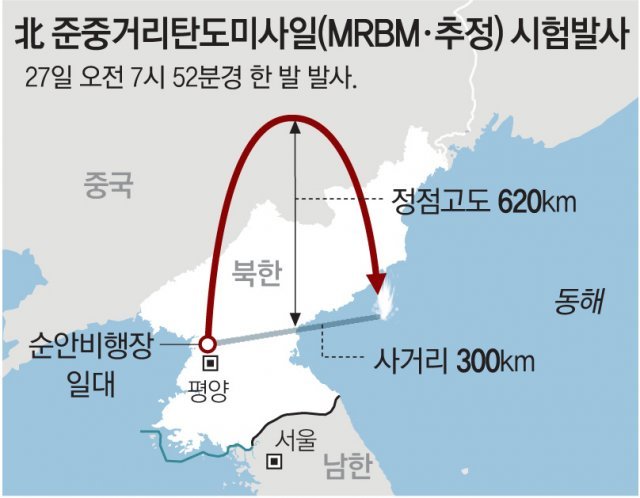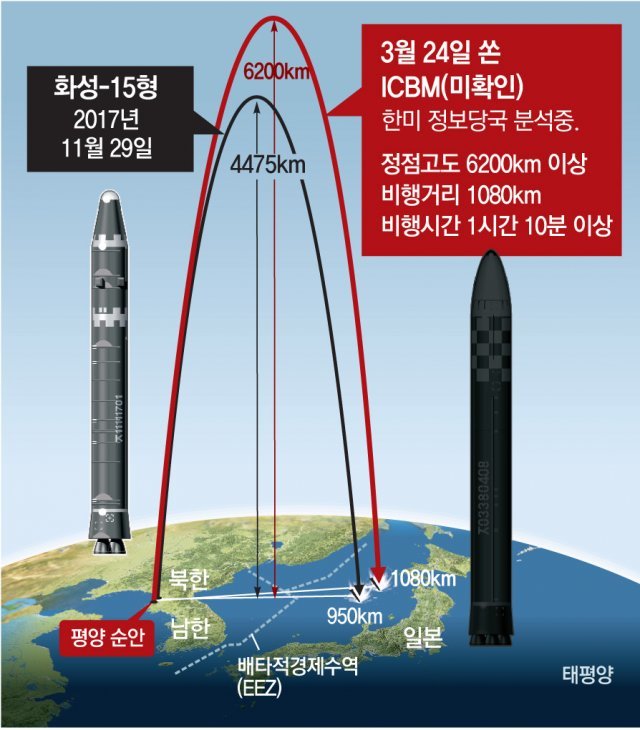February 27, 2022
North Korea launched a projectile "presumed to be a ballistic missile" into the East Sea from Sunan airfield where Pyongyang's international airport is located at 7:52 a.m.(KST). Pyongyang reportedly launched the ballistic missile from a transporter erector launcher(TEL). The missile might have flown some 300 kilometers (186 miles) with an altitude reaching 620 kilometers, according to the South's Joint Chiefs of Staff. The missile's flight path indicates that North Korea could have launched a medium-range ballistic missile on a lofted and high-angle trajectory.
The South Korean military mentioned the possibility that it was a two-stage and solid-fueled Pukguksong-2 or KN-15 medium-range ballistic missile.
This eighth launch since January meant a resumption of North Korea's missile provocations 28 days after a short break during the Beijing Winter Olympics from Feb. 4 to 20. And it came less than two weeks ahead of South Korea's March 9 presidential election.
North Korea's state-run news agency KCNA reported the test was for the development of a reconnaissance satellite system. But most feared that North Korea might push ahead with missile development while international attention was focused on Russia's invasion of Ukraine.
On Feb. 28, 11 UN member countries, led by the United States, released a joint statement that called on UN Security Council members "to speak with one voice in condemning these dangerous and unlawful acts." Some analysts saw North Korea's move as foreshadowing a withdrawal of its moratorium on ICBM and nuclear testing. (source: The Korea Herald, Korea Joongang Daily)
 |
(source: Donga-ilbo) |
March 5, 2022
North Korea fired a ballistic missile toward the East Sea, its ninth show of force in 2022. Launched from around the Sunan area in Pyongyang at 8:48 a.m.(KST), the missile flew about 270 kilometers to the east at a top altitude of 560 km, South Korea's Joint Chiefs of Staff said.
The KCNA reported the North's National Aerospace Development Administration and the Academy of Defense Science conducted another important test under the plan of developing a reconnaissance satellite.
North Korea insisted that "through the test, the NADA confirmed the reliability of data transmission and reception system of the satellite, its control command system, and various gound-based control systems." On Jan. 9, 2021, Kim Jong-un revealed a long list of new weapons systems the regime was developing, including reconnaissance satellites, at the congress of the ruling Workers' Party of Korea. Developing such technology is largely seen as the North's attempt to fire an ICBM. This is because delivering the satellite into orbit requires a long-range rocket launch, which uses similar technology to ICBMs.
South Korean and U.S. intelligence believe that the purported satellite missile launches were actually tests of the Hwasong-17 ICBM, which was first unveiled at an Oct.10, 2020 military parade. With an estimated length of 23 meters and a 2.3-meter diameter, the Hwasong-17 is the largest ICBM in the world.
On March 10, the U.S. Ministry of Defence published in an intelligence report that the two recent missile launches conducted by the North were experimental launches for a new ICBM. Right after that, the U.S. Treasury Department imposed sanctions on two Russian individuals and three entities for enabling North Korea's illicit weapons program. (source: Reuters, Korea Herald, Korea Joongang Daily)
 |
| (source: Donga-ilbo) |
March 16, 2022
North Korea launched an unidentified projectile from Sunan Airport near Pyongyang at around 9:30 a.m.(KST) but the test failed almost immediately. It was suspected to be a long-range ballistic missile. The projectile exploded at an altitude of less than 20 kilometers (12.4 miles). The mid-air explosion sprayed debris over areas near the capital, according to NK News.
It was its first launch since the conservative People Power Party's Yoon Suk-yeol won in the March 9 presidential election.
South Korea's military authorities put weight to the possibility the latest launch involved the same intercontinental ballistic missile(ICBM) that the North tested on Feb. 27 and March 5. (source: Korea Joongang Daily)
 |
North Korea's first provocation after the presidential election failed due to an explosion |
March 20, 2022
Meanwhile, according to the written testimony of blockchain data firm, Chainalysis, submitted to the U.S. Senate Committee on Banking, Housing, and Urban Affairs, North Korean hackers launched at least seven attacks on cryptocurrency platforms in 2021 and stole nearly $400 million worth of digital assets. The report said that the revenue generated from these illicit hacks goes to support North Korea's weapons of mass destruction and ballistic missile programs, citing the UN Security Council. (source: Korea Joongang Daily, Korea Herald)
 |
Multiple rocket Launchers at North Korea's military parade |
March 24, 2022
North Korea fired an intercontinental ballistic missile and other unidentified projectiles after more than a four-year hiatus, breaking its self-imposed moratorium on ICBM and nuclear tests.
Pyongyang launched an ICBM-class projectile that flew more than one hour and 10 minutes toward the East Sea at 2:34 p.m. from the Sunan area near Pyongyang. The ICBM flew around 1,080 kilometers at an altitude of 6,200 km or higher, the South's Joint Chiefs of Staff said, adding that the missile is presumed to have been fired at a high angle and with a lofted trajectory. The Japanese Coast Guard said the projectile was possibly a ballistic missile and that it was believed to have landed 170 kilometers west of Cape Tappi in Aomori Prefecture, inside Japan's exclusive economic zone(EEZ).
On March 25, North Korea said that it successfully test-fired a new ICBM, called the Hwasong-17, on the direct order of its leader Kim Jong-un. And on March 28, Kim Jong-un stressed his country would further develop a powerful strike means to reinforce national defense capabilities. (source: Yonhap News)
But South Korea and the United States believe the North tested a Hwasong-15 ICBM, the same type it fired in late 2017, and disguised its launch as that of a Hwasong-17 after an analysis of the missile's engine nozzles and engine combustion time.
On April 2, the U.S. Department of the Treasury imposed sanctions on five North Korean entities, including the Ministry of Rocket Industry involved in the North's recent missile tests that included its first ICBM launch in over four years. (source: Korea Herald, Washington Post, Yonhap News)
 |
Kim Jong-un and new-type ICBM Hwasong-17 |
 |
| (source : Donga-ilbo) |

.png)

Comments
Post a Comment